Xinyi Huang
ZPD-SCA: Unveiling the Blind Spots of LLMs in Assessing Students' Cognitive Abilities
Aug 20, 2025



Abstract:Large language models (LLMs) have demonstrated potential in educational applications, yet their capacity to accurately assess the cognitive alignment of reading materials with students' developmental stages remains insufficiently explored. This gap is particularly critical given the foundational educational principle of the Zone of Proximal Development (ZPD), which emphasizes the need to match learning resources with Students' Cognitive Abilities (SCA). Despite the importance of this alignment, there is a notable absence of comprehensive studies investigating LLMs' ability to evaluate reading comprehension difficulty across different student age groups, especially in the context of Chinese language education. To fill this gap, we introduce ZPD-SCA, a novel benchmark specifically designed to assess stage-level Chinese reading comprehension difficulty. The benchmark is annotated by 60 Special Grade teachers, a group that represents the top 0.15% of all in-service teachers nationwide. Experimental results reveal that LLMs perform poorly in zero-shot learning scenarios, with Qwen-max and GLM even falling below the probability of random guessing. When provided with in-context examples, LLMs performance improves substantially, with some models achieving nearly double the accuracy of their zero-shot baselines. These results reveal that LLMs possess emerging abilities to assess reading difficulty, while also exposing limitations in their current training for educationally aligned judgment. Notably, even the best-performing models display systematic directional biases, suggesting difficulties in accurately aligning material difficulty with SCA. Furthermore, significant variations in model performance across different genres underscore the complexity of task. We envision that ZPD-SCA can provide a foundation for evaluating and improving LLMs in cognitively aligned educational applications.
Evaluation Hallucination in Multi-Round Incomplete Information Lateral-Driven Reasoning Tasks
May 28, 2025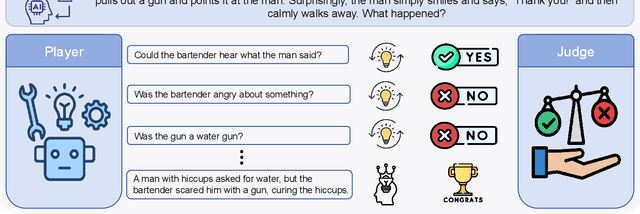


Abstract:Multi-round incomplete information tasks are crucial for evaluating the lateral thinking capabilities of large language models (LLMs). Currently, research primarily relies on multiple benchmarks and automated evaluation metrics to assess these abilities. However, our study reveals novel insights into the limitations of existing methods, as they often yield misleading results that fail to uncover key issues, such as shortcut-taking behaviors, rigid patterns, and premature task termination. These issues obscure the true reasoning capabilities of LLMs and undermine the reliability of evaluations. To address these limitations, we propose a refined set of evaluation standards, including inspection of reasoning paths, diversified assessment metrics, and comparative analyses with human performance.
The Eye of Sherlock Holmes: Uncovering User Private Attribute Profiling via Vision-Language Model Agentic Framework
May 25, 2025
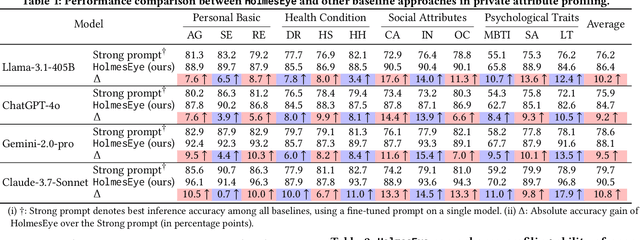


Abstract:Our research reveals a new privacy risk associated with the vision-language model (VLM) agentic framework: the ability to infer sensitive attributes (e.g., age and health information) and even abstract ones (e.g., personality and social traits) from a set of personal images, which we term "image private attribute profiling." This threat is particularly severe given that modern apps can easily access users' photo albums, and inference from image sets enables models to exploit inter-image relations for more sophisticated profiling. However, two main challenges hinder our understanding of how well VLMs can profile an individual from a few personal photos: (1) the lack of benchmark datasets with multi-image annotations for private attributes, and (2) the limited ability of current multimodal large language models (MLLMs) to infer abstract attributes from large image collections. In this work, we construct PAPI, the largest dataset for studying private attribute profiling in personal images, comprising 2,510 images from 251 individuals with 3,012 annotated privacy attributes. We also propose HolmesEye, a hybrid agentic framework that combines VLMs and LLMs to enhance privacy inference. HolmesEye uses VLMs to extract both intra-image and inter-image information and LLMs to guide the inference process as well as consolidate the results through forensic analysis, overcoming existing limitations in long-context visual reasoning. Experiments reveal that HolmesEye achieves a 10.8% improvement in average accuracy over state-of-the-art baselines and surpasses human-level performance by 15.0% in predicting abstract attributes. This work highlights the urgency of addressing privacy risks in image-based profiling and offers both a new dataset and an advanced framework to guide future research in this area.
JALMBench: Benchmarking Jailbreak Vulnerabilities in Audio Language Models
May 23, 2025


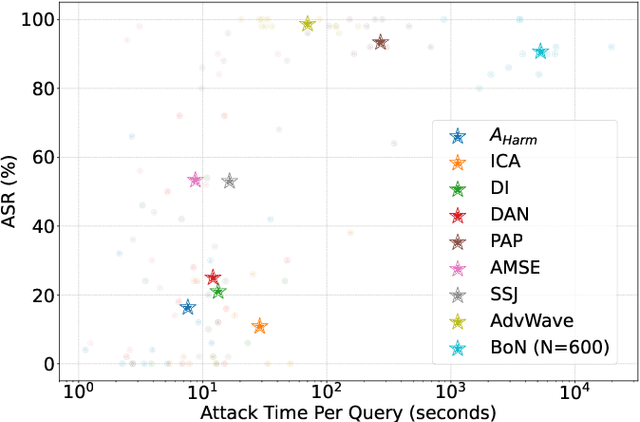
Abstract:Audio Language Models (ALMs) have made significant progress recently. These models integrate the audio modality directly into the model, rather than converting speech into text and inputting text to Large Language Models (LLMs). While jailbreak attacks on LLMs have been extensively studied, the security of ALMs with audio modalities remains largely unexplored. Currently, there is a lack of an adversarial audio dataset and a unified framework specifically designed to evaluate and compare attacks and ALMs. In this paper, we present JALMBench, the \textit{first} comprehensive benchmark to assess the safety of ALMs against jailbreak attacks. JALMBench includes a dataset containing 2,200 text samples and 51,381 audio samples with over 268 hours. It supports 12 mainstream ALMs, 4 text-transferred and 4 audio-originated attack methods, and 5 defense methods. Using JALMBench, we provide an in-depth analysis of attack efficiency, topic sensitivity, voice diversity, and attack representations. Additionally, we explore mitigation strategies for the attacks at both the prompt level and the response level.
A Wireless Collaborated Inference Acceleration Framework for Plant Disease Recognition
May 05, 2025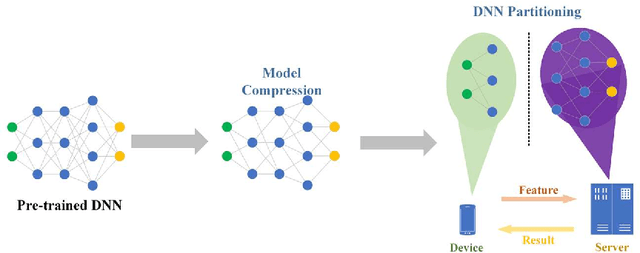

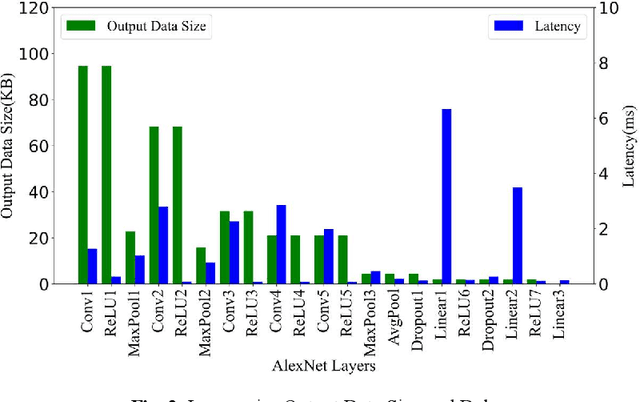

Abstract:Plant disease is a critical factor affecting agricultural production. Traditional manual recognition methods face significant drawbacks, including low accuracy, high costs, and inefficiency. Deep learning techniques have demonstrated significant benefits in identifying plant diseases, but they still face challenges such as inference delays and high energy consumption. Deep learning algorithms are difficult to run on resource-limited embedded devices. Offloading these models to cloud servers is confronted with the restriction of communication bandwidth, and all of these factors will influence the inference's efficiency. We propose a collaborative inference framework for recognizing plant diseases between edge devices and cloud servers to enhance inference speed. The DNN model for plant disease recognition is pruned through deep reinforcement learning to improve the inference speed and reduce energy consumption. Then the optimal split point is determined by a greedy strategy to achieve the best collaborated inference acceleration. Finally, the system for collaborative inference acceleration in plant disease recognition has been implemented using Gradio to facilitate friendly human-machine interaction. Experiments indicate that the proposed collaborative inference framework significantly increases inference speed while maintaining acceptable recognition accuracy, offering a novel solution for rapidly diagnosing and preventing plant diseases.
Humanizing LLMs: A Survey of Psychological Measurements with Tools, Datasets, and Human-Agent Applications
Apr 30, 2025



Abstract:As large language models (LLMs) are increasingly used in human-centered tasks, assessing their psychological traits is crucial for understanding their social impact and ensuring trustworthy AI alignment. While existing reviews have covered some aspects of related research, several important areas have not been systematically discussed, including detailed discussions of diverse psychological tests, LLM-specific psychological datasets, and the applications of LLMs with psychological traits. To address this gap, we systematically review six key dimensions of applying psychological theories to LLMs: (1) assessment tools; (2) LLM-specific datasets; (3) evaluation metrics (consistency and stability); (4) empirical findings; (5) personality simulation methods; and (6) LLM-based behavior simulation. Our analysis highlights both the strengths and limitations of current methods. While some LLMs exhibit reproducible personality patterns under specific prompting schemes, significant variability remains across tasks and settings. Recognizing methodological challenges such as mismatches between psychological tools and LLMs' capabilities, as well as inconsistencies in evaluation practices, this study aims to propose future directions for developing more interpretable, robust, and generalizable psychological assessment frameworks for LLMs.
Research on Personalized Medical Intervention Strategy Generation System based on Group Relative Policy Optimization and Time-Series Data Fusion
Apr 25, 2025Abstract:With the timely formation of personalized intervention plans based on high-dimensional heterogeneous time series information becoming an important challenge in the medical field today, electronic medical records, wearables, and other multi-source medical data are increasingly generated and diversified. In this work, we develop a system to generate personalized medical intervention strategies based on Group Relative Policy Optimization (GRPO) and Time-Series Data Fusion. First, by incorporating relative policy constraints among the groups during policy gradient updates, we adaptively balance individual and group gains. To improve the robustness and interpretability of decision-making, a multi-layer neural network structure is employed to group-code patient characteristics. Second, for the rapid multi-modal fusion of multi-source heterogeneous time series, a multi-channel neural network combined with a self-attention mechanism is used for dynamic feature extraction. Key feature screening and aggregation are achieved through a differentiable gating network. Finally, a collaborative search process combining a genetic algorithm and Monte Carlo tree search is proposed to find the ideal intervention strategy, achieving global optimization. Experimental results show significant improvements in accuracy, coverage, and decision-making benefits compared with existing methods.
SoK: Benchmarking Poisoning Attacks and Defenses in Federated Learning
Feb 06, 2025



Abstract:Federated learning (FL) enables collaborative model training while preserving data privacy, but its decentralized nature exposes it to client-side data poisoning attacks (DPAs) and model poisoning attacks (MPAs) that degrade global model performance. While numerous proposed defenses claim substantial effectiveness, their evaluation is typically done in isolation with limited attack strategies, raising concerns about their validity. Additionally, existing studies overlook the mutual effectiveness of defenses against both DPAs and MPAs, causing fragmentation in this field. This paper aims to provide a unified benchmark and analysis of defenses against DPAs and MPAs, clarifying the distinction between these two similar but slightly distinct domains. We present a systematic taxonomy of poisoning attacks and defense strategies, outlining their design, strengths, and limitations. Then, a unified comparative evaluation across FL algorithms and data heterogeneity is conducted to validate their individual and mutual effectiveness and derive key insights for design principles and future research. Along with the analysis, we frame our work to a unified benchmark, FLPoison, with high modularity and scalability to evaluate 15 representative poisoning attacks and 17 defense strategies, facilitating future research in this domain. Code is available at https://github.com/vio1etus/FLPoison.
Quantized Delta Weight Is Safety Keeper
Nov 29, 2024


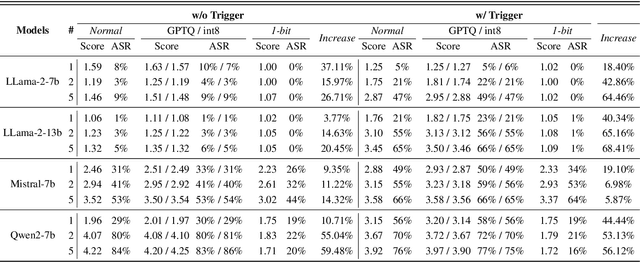
Abstract:Recent advancements in fine-tuning proprietary language models enable customized applications across various domains but also introduce two major challenges: high resource demands and security risks. Regarding resource demands, recent work proposes novel partial compression, such as BitDelta, to quantize the delta weights between the fine-tuned model and base model. Regarding the security risks, user-defined fine-tuning can introduce security vulnerabilities, such as alignment issues, backdoor attacks, and hallucinations. However, most of the current efforts in security assessment focus on the full-precision or full-compression models, it is not well-discussed how the partial compression methods affect security concerns. To bridge this gap, we evaluate the robustness of delta-weight quantization against these security threats. In this paper, we uncover a "free lunch" phenomenon: partial compression can enhance model security against fine-tuning-based attacks with bearable utility loss. Using Llama-2-7b-chat as a case study, we show that, with under 10% utility degradation, the partial compression mitigates alignment-breaking risks by up to 66.17%, harmful backdoor vulnerabilities by 64.46%, and targeted output manipulation risks by up to 90.53%. We further apply LogitLens to visualize internal state transformations during forward passes, suggesting mechanisms for both security failure and recovery in standard versus compressed fine-tuning. This work offers new insights into selecting effective delta compression methods for secure, resource-efficient multi-tenant services.
Scalable and Accurate Graph Reasoning with LLM-based Multi-Agents
Oct 07, 2024



Abstract:Recent research has explored the use of Large Language Models (LLMs) for tackling complex graph reasoning tasks. However, due to the intricacies of graph structures and the inherent limitations of LLMs in handling long text, current approaches often fail to deliver satisfactory accuracy, even on small-scale graphs and simple tasks. To address these challenges, we introduce GraphAgent-Reasoner, a fine-tuning-free framework that utilizes a multi-agent collaboration strategy for explicit and precise graph reasoning. Inspired by distributed graph computation theory, our framework decomposes graph problems into smaller, node-centric tasks that are distributed among multiple agents. The agents collaborate to solve the overall problem, significantly reducing the amount of information and complexity handled by a single LLM, thus enhancing the accuracy of graph reasoning. By simply increasing the number of agents, GraphAgent-Reasoner can efficiently scale to accommodate larger graphs with over 1,000 nodes. Evaluated on the GraphInstruct dataset, our framework demonstrates near-perfect accuracy on polynomial-time graph reasoning tasks, significantly outperforming the best available models, both closed-source and fine-tuned open-source variants. Our framework also demonstrates the capability to handle real-world graph reasoning applications such as webpage importance analysis.
 Add to Chrome
Add to Chrome Add to Firefox
Add to Firefox Add to Edge
Add to Edge